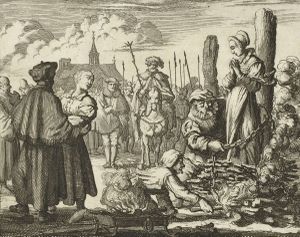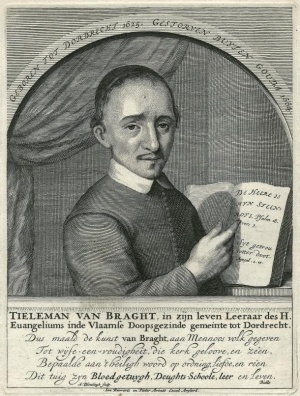Braght, Tieleman Jansz van (1625-1664)
Tieleman Jansz van Braght, a Dutch Mennonite elder, was born 29 January 1625 in Dordrecht, and died 7 October 1664. His father, like Tieleman van Braght himself, was a cloth merchant. The boy showed great talent. He applied himself at first to a study of languages and learned Latin, Greek, Hebrew, French, and German. In 1648 he was made preacher in his home town, and served in that office for 16 years, until his death. He was a warm defender of Mennonite principles, engaged in disputes on the streets, on ships, or wherever the occasion offered itself. One of his best-known disputes was that with Gerardus Aemilius, the Reformed pastor of Oud-Beyerland, chiefly on the subject of infant baptism. Van Braght's knowledge, learning, skill in the Scriptures were clearly shown on this occasion.
Van Braght played an important role in the difficulties that developed in Holland about 1660 between the more progressive and the conservative Mennonites. He was completely on the side of the conservatives. The conservatives offered him the eldership of their Rotterdam congregation, but he declined it. In Utrecht he helped to depose the more progressive preachers, among them Willem van Maurik. Van Braght was the chairman of the Synod of Leiden of June 1660, where the conservative Mennonites united against Collegiantism.

Engraving by Jan Luiken in Martyrs Mirror, v. 2, p. 65 of Dutch edition.
Source: Rijksmuseum.
In 1657 van Braght published his School der zedelijke deugd (School of Moral Virtue) to deter the young people from unvirtuous living and lead them to the true fear of God. This little work went through 18 editions. The original title was De Schole der zedelijcke Deught, geopent voor de kinderen der Christenen. With the eighth edition the word “zedelijcke” was omitted. The 18th edition appeared in 1824. But he became more famous for his publication of the Martyrs' Mirror, which appeared under the following (1685) title: Het Bloedig Tooneel of Martelaersspiegel der Doops-gesinde of Weerelose Christenen, Die om't getuygenis van Jesus haren Salighmaker geleden hebben ende gedood zijn, van Christi tijd af tot desen tijd toe. Versamelt uyt verscheyde geloofweerdige Chronijken, Memorien en Getuygenissen. Door T. J. V. Braght, Den Tweeden Druk. Bysonder vermeerdert met veele Autentijcke Stucken en over de hondert curieuse Konstplaten. The first edition appeared in 1660, the second in 1685 with copper engravings by Jan Luiken. The foreword of his first edition indicates his original plan to print the martyr book of 1631 without change, merely adding martyrs who had been discovered since that date; but he went much further. He gathered much information from city archives and made successful use of it. He also visited the congregations in South Germany; in March 1662 he was in Obersülzheim near Worms in the Palatinate. He was thus able to replace erroneous reports with correct ones, and did not hesitate to publish what had been hitherto uncertain or unknown.
According to modern standards his method of work was not scholarly; he accepted and published whole articles without checking their accuracy, and was historically inexact. His preferences and aversions also played a part. It must not be forgotten that he wrote for the purpose of edifying. But on the whole he can be considered reliable; nowhere is there intentional falsification. His reliability was thoroughly established by the late Samuel Cramer (DB 1899 and 1900). His work soon superseded the older martyr books. The Offer des Heeren, first published in 1562, as well as the other martyr books, was no longer widely known in the 18th century. A glance at the new edition of the Offer des Heeren (1904) shows how much of it van Braght used, but also that he altered it independently. His treatment of baptism, for instance, which he added for each century, is quite extensive and independent. Anyone wishing information concerning our oldest martyrs cannot afford to overlook van Braght, and will be amazed at the breadth of his reading and the fluency of his style. His fluency likely brought him fewer happy hours, for in 1660 he was summoned before the Reformed Church to answer for the boldness of his tone; but he managed to defend himself so well that his good name was merely enhanced thereby.
As a preacher van Braght was widely celebrated. The sermons which his brother published (51 Predicatien, over verscheyde Schriftuerplaetsen, Amsterdam, 1670, with portrait) are, to be sure, not the best that he produced. The Reformed Chr. Schotanus in Van de Gronden der Mennistery ofte Waerschouwinghe over ‘t Bloed-tooneel van de Doopsgezinde van T. J. v. Bracht (Leeuwarden, 1671) warns against the Martyrs Mirror.
Tieleman van Braght also wrote some hymns; a few of them are inserted in the songbook of Klaas Stapel, Lusthof des Gemoeds (1681). T. van Bracht (or Braght), who is likely identical with the Dordrecht elder Tieleman van Braght, is the author of the following poems: Anghstigh Swanengezangh, of Troostelooze Vreede (Dordrecht, 1647); Kristus in't Vleesch, Kersgesang (Dordrecht, 1716); De gewiekte Kruiwagen (Dordrecht, 1717); Uitbreiding over Konings Salomons Lied der Liederen en Psalm XLV (Delft, 1719).
Besides Tieleman Jansz van Braght there were other van Braghts at Dordrecht, among them Cornelis van Braght, elder of the Dordrecht congregation from 1689 on and also a poet. Pieter van Braght, who was a brother of Tieleman, also wrote poems. (DB 1862, 104, 106.)
Bibliography
Cate, Steven Blaupot ten. Geschiedenis der Doopsgezinden in Holland, Zeeland, Utrecht en Gelderland, 2 vols. Amsterdam: P.N. van Kampen, 1847: I, 197-199, 285-287.
Doopsgezind Jaarboekje (1837): 96
Doopsgezinde Bijdragen (1862): 103 ff.; (1864): 125; (1869): 21 ff.; (1881): 35; (1882): 41; (1884): 39; (1887): 92; (1892): 72, 84; (1899): 65-164; (1900): 184-210; (1902): 170.
Franz, Günther. Urkundliche Quellen zur hessischen Reformationsgeschichte. Vierter Band, Wiedertäuferakten 1527-1626. Marburg: N.G. Elwert, 1951: 21-28, 180-183, 266, 277.
Haeghen, Ferdinand van der., Thomas Arnold and R. Vanden Berghe. Bibliographie des Martyrologes Protestants Néerlandais. II. Receuils. The Hague: M. Nijhoff, 1890: I, 21-77.
Hege, Christian and Christian Neff. Mennonitisches Lexikon, 4 vols. Frankfurt & Weierhof: Hege; Karlsruhe: Schneider, 1913-1967: v. I, 252.
Hoop Scheffer, Jacob Gijsbert de. Inventaris der Archiefstukken berustende bij de Vereenigde Doopsgezinde Gemeente to Amsterdam, 2 vols. Amsterdam: Uitgegeven en ten geschenke aangeboden door den Kerkeraad dier Gemeente, 1883-1884: I, Nos. 612, 613.
Schijn, Hermann. Geschiedenis dier Christenen, welke in de Vereenigde Nederlanden onder de Protestanten Mennoniten genaamd worden . . . Tweede Druk op nieuws uit het Latyn vertaald, en vermeerdert door Gerardus Maatschoen. Amsterdam: Kornelis de Wit, 1743-1745: II, 534-540, with portrait.
Visscher, H. and L. A. van Langeraad. Biographisch Woordenboek von Protestantsche Godgeleerden in Nederland. Utrecht, 1903-: I, 554-555.
| Author(s) | H. Westra |
|---|---|
| Nanne van der Zijpp | |
| Date Published | 1953 |
Cite This Article
MLA style
Westra, H. and Nanne van der Zijpp. "Braght, Tieleman Jansz van (1625-1664)." Global Anabaptist Mennonite Encyclopedia Online. 1953. Web. 24 Nov 2024. https://gameo.org/index.php?title=Braght,_Tieleman_Jansz_van_(1625-1664)&oldid=141505.
APA style
Westra, H. and Nanne van der Zijpp. (1953). Braght, Tieleman Jansz van (1625-1664). Global Anabaptist Mennonite Encyclopedia Online. Retrieved 24 November 2024, from https://gameo.org/index.php?title=Braght,_Tieleman_Jansz_van_(1625-1664)&oldid=141505.
Adapted by permission of Herald Press, Harrisonburg, Virginia, from Mennonite Encyclopedia, Vol. 1, pp. 400-401. All rights reserved.
©1996-2024 by the Global Anabaptist Mennonite Encyclopedia Online. All rights reserved.

